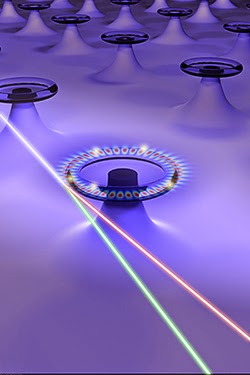 |
| IMAGE BY J. ZHU, B. PENG, S.K. OZDEMIR, L. YANG * |
Nanoparticles, engineered materials about a billionth of a meter in size, are around us every day. Although they are tiny, they can benefit human health, as in some innovative early cancer treatments, but they can also interfere with it through viruses, air pollution, traffic emissions, cosmetics, sunscreen and electronics.
A team of researchers at Washington University in St. Louis, led by Lan Yang, PhD, the Das Family Career Development Associate Professor in Electrical & Systems Engineering, and their collaborators at Tsinghua University in China have developed a new sensor that can detect and count nanoparticles, at sizes as small as 10 nanometers, one at a time. The researchers say the sensor could potentially detect much smaller particles, viruses and small molecules.
The research appears in the Proceedings of the National Academy of Sciences online Early Edition Sept. 1, 2014.
* Arrays of self-referenced and self-heterodyned Whispering-Gallery Raman microlasers for single nanoparticle detection. A “pump” laser generates a single Raman lasing mode inside the silica resonators. Upon landing of a nanoparticle on the resonator, Raman laser circulating inside the resonator undergo mode splitting leading to two new lasing modes in different colors. Monitoring the changes in the color difference (frequency difference) enables detecting and measuring of nanoparticles with single particle resolution.
Washington University in St. Louis Newsroom:
Engineers develop new sensor to detect tiny individual nanoparticles,
Tony Fitzpatrick
Comments